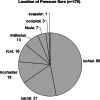Local flap therapy for the treatment of pressure sore wounds
- PMID: 24131657
- PMCID: PMC7950397
- DOI: 10.1111/iwj.12166
Local flap therapy for the treatment of pressure sore wounds
Abstract
The aim of this study was to analyse the effectiveness of an interdisciplinary cooperation between conservative and surgical disciplines for the treatment of pressure sores (PS). From January 2004 to December 2005, a single-centre study was performed with paraplegic and tetraplegic patients presenting with PS grades III-V. Outcome measures were defect size, grade, method of reconstruction, complication and recurrence rate as well as average length of hospitalisation. A total of 119 patients aged 22-84 years with totally 170 PS were included. The most common PS were located in the ischial region (47%), followed by the sacral (18%), trochanteric (11%), foot (9%) and the malleolar (8%) regions. Defect sizes ranged between 4 and 255 cm(2) . Grade IV was the most common PS (68%), followed by grade III (30%) and grade V (2%) PS. For wound closure, fasciocutaneous flaps were used most frequently (71%), followed by skin grafts (10%) and myocutaneous flaps (7%). Postoperative follow-up ranged between 6 and 38 months. The overall complication and recurrence rate was 26% and 11%, respectively. If no complication occurred, the average duration of hospitalisation stay after the first debridement was 98 ± 62 days. In conclusion, our treatment concept is reliable, effective and results in a low recurrence rate. The complication rate, even though favourable when compared with the literature, still needs to be improved.
Keywords: Interdisciplinary communication; Pressure sore; Recurrence.
© 2013 The Authors. International Wound Journal © 2013 Medicalhelplines.com Inc and John Wiley & Sons Ltd.
Figures



Similar articles
-
The posterior thigh flap for defect coverage of ischial pressure sores - a critical single-centre analysis.Int Wound J. 2017 Dec;14(6):1154-1159. doi: 10.1111/iwj.12776. Epub 2017 Jun 29. Int Wound J. 2017. PMID: 28661069 Free PMC article.
-
Management of recurrent ischial pressure sore with gracilis muscle flap and V-Y profunda femoris artery perforator-based flap.J Plast Reconstr Aesthet Surg. 2009 Oct;62(10):1339-46. doi: 10.1016/j.bjps.2007.12.092. Epub 2008 Jul 2. J Plast Reconstr Aesthet Surg. 2009. PMID: 18595789
-
[Clinical typing and surgical principle of pressure sore].Zhongguo Xiu Fu Chong Jian Wai Ke Za Zhi. 2007 Sep;21(9):932-6. Zhongguo Xiu Fu Chong Jian Wai Ke Za Zhi. 2007. PMID: 17933225 Chinese.
-
Long-term outcome of pressure sores treated with flap coverage.Plast Reconstr Surg. 1997 Oct;100(5):1212-7. doi: 10.1097/00006534-199710000-00021. Plast Reconstr Surg. 1997. PMID: 9326782
-
A retrospective study: Multivariate logistic regression analysis of the outcomes after pressure sores reconstruction with fasciocutaneous, myocutaneous, and perforator flaps.J Plast Reconstr Aesthet Surg. 2017 Aug;70(8):1038-1043. doi: 10.1016/j.bjps.2017.04.004. Epub 2017 Apr 23. J Plast Reconstr Aesthet Surg. 2017. PMID: 28552279
Cited by
-
Treatment and cost of pressure injury stage III or IV in four patients with spinal cord injury: the Basel Decubitus Concept.Spinal Cord Ser Cases. 2019 Mar 15;5:30. doi: 10.1038/s41394-019-0173-0. eCollection 2019. Spinal Cord Ser Cases. 2019. PMID: 31632697 Free PMC article.
-
Risk factors for recurrent pressure ulcers after reconstructive surgery: A retrospective study in a single medical centre.Int Wound J. 2023 Sep;20(7):2511-2517. doi: 10.1111/iwj.14112. Epub 2023 Feb 8. Int Wound J. 2023. PMID: 36756688 Free PMC article.
-
Osteomyelitis and antibiotic treatment in patients with grade IV pressure injury and spinal cord lesion-a retrospective cohort study.Spinal Cord. 2022 Jun;60(6):540-547. doi: 10.1038/s41393-022-00758-1. Epub 2022 Feb 4. Spinal Cord. 2022. PMID: 35121846
-
Nutritional blood parameters and nutritional risk screening in patients with spinal cord injury and deep pressure ulcer-a retrospective chart analysis.Spinal Cord. 2018 Feb;56(2):168-175. doi: 10.1038/s41393-017-0016-4. Epub 2017 Oct 23. Spinal Cord. 2018. PMID: 29057992
-
The posterior thigh flap for defect coverage of ischial pressure sores - a critical single-centre analysis.Int Wound J. 2017 Dec;14(6):1154-1159. doi: 10.1111/iwj.12776. Epub 2017 Jun 29. Int Wound J. 2017. PMID: 28661069 Free PMC article.
References
-
- Sumiya T, Kawamura K, Tokuhiro A, Takechi H, Ogata H. A survey of wheelchair use by paraplegic individuals in Japan. Part 2: prevalence of pressure sores. Spinal Cord 1997;35:595–8. - PubMed
-
- Braden B, Bergstrom N. A conceptual schema for the study of the etiology of pressure sores. Rehabil Nurs 1987;12:8–12. - PubMed
-
- Allman RM, Goode PS, Burst N, Bartolucci AA, Thomas DR. Pressure ulcers, hospital complications, and disease severity: impact on hospital costs and length of stay. Adv Wound Care 1999;12:22–30. - PubMed
-
- Smith DM. Pressure ulcers in the nursing home. Ann Intern Med 1995;123:433–42. - PubMed
MeSH terms
LinkOut - more resources
Full Text Sources
Other Literature Sources
Medical

